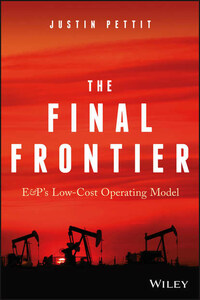The Final Frontier
E&P’s Low-Cost
Operating Model
Justin Pettit
Copyright © 2017 by Justin Pettit. All rights reserved.
Published by John Wiley & Sons, Inc., Hoboken, New Jersey.
Published simultaneously in Canada.
No part of this publication may be reproduced, stored in a retrieval system, or transmitted in any form or by any means, electronic, mechanical, photocopying, recording, scanning, or otherwise, except as permitted under Section 107 or 108 of the 1976 United States Copyright Act, without either the prior written permission of the Publisher, or authorization through payment of the appropriate per-copy fee to the Copyright Clearance Center, Inc., 222 Rosewood Drive, Danvers, MA 01923, (978) 750-8400, fax (978) 646-8600, or on the Web at www.copyright.com. Requests to the Publisher for permission should be addressed to the Permissions Department, John Wiley & Sons, Inc., 111 River Street, Hoboken, NJ 07030, (201) 748-6011, fax (201) 748-6008, or online at http://www.wiley.com/go/permissions.
Limit of Liability/Disclaimer of Warranty: While the publisher and author have used their best efforts in preparing this book, they make no representations or warranties with respect to the accuracy or completeness of the contents of this book and specifically disclaim any implied warranties of merchantability or fitness for a particular purpose. No warranty may be created or extended by sales representatives or written sales materials. The advice and strategies contained herein may not be suitable for your situation. You should consult with a professional where appropriate. Neither the publisher nor author shall be liable for any loss of profit or any other commercial damages, including but not limited to special, incidental, consequential, or other damages.
For general information on our other products and services or for technical support, please contact our Customer Care Department within the United States at (800) 762-2974, outside the United States at (317) 572-3993 or fax (317) 572-4002.
Wiley publishes in a variety of print and electronic formats and by print-on-demand. Some material included with standard print versions of this book may not be included in e-books or in print-on-demand. If this book refers to media such as a CD or DVD that is not included in the version you purchased, you may download this material at http://booksupport.wiley.com. For more information about Wiley products, visit www.wiley.com.
Library of Congress Cataloging-in-Publication Data is available:
ISBN 9781119376545 (Hardcover)
ISBN 9781119376576 (ePDF)
ISBN 9781119376569 (ePub)
Cover Design: Wiley
Cover Image: © ImagineGolf/Getty Images
To Krista, Trevor, Maddie, and Teddy, for their laughter, love, and patience
I wish to thank the many people with whom I have had the pleasure of working over the past many years, for kindly providing the impetus, expertise, and resources to produce this book, especially my former partners and colleagues from Booz, UBS, and Stern Stewart & Co. I would also like to thank my previous editors, including David Champion, Don Chew, Art Klein, and Krista Pettit, for teaching me not to write like a scientist.
However, the views expressed herein are solely my own. Moreover, any errors or omissions are strictly my own.
I also wish to thank my IHS colleagues, including Ulviyya Abdullayeva, Ruslan Anisimov, Kurt Barrow, Stephen Beck, Ryan Carbrey, Andrew Day, Erik Darner, Jean Dugan, Blake Eskew, Steve Fekete, Philippe Frangules, Bob Fryklund, Etienne Gabel, Mark Griffith, Tim Hemsted, Mark Jelinek, Ed Kelly, Jerry Kepes, Chris Kiser, Roger Kranenburg, Mike Kratochwill, Nick Lowes, Fernanda Machado, Michael Marinovic, Paul Markwell, Michael Muirhead, Gil Nebeker, Charlie O'Brien, Alastair Reid, Darryl Rogers, Jamey Rosenfield, Senjit Sarkar, Ed Scardaville, Grigorij Serscikov, Nick Sharma, Curtis Smith, Leta Smith, James Stevenson, Dale Struksnes, Jim Thomas, Rodrigo Vaz, Dan Yergin, and Tim Zoba.
Finally, I wish to thank the many clients who have challenged and entrusted me with their needs and encourage them to please continue to do so!
This book guides the reader through the redesign elements for the internal operating model of an enterprise in the oil and gas sector – including integrated oil companies (IOCs), majors and independents, national oil companies (NOCs), and services companies in the upstream supply chain. For simplicity, this book references these companies as Exploration and Production (E&P) companies.
A culmination of disruptive forces and evolutionary change in the oil and gas industry has conspired together to make the case for a new low‐cost operating model. The industry has experienced tremendous evolution in terms of: our understanding of the underlying global resource base, the nature of its ownership and principal stakeholders, technologies and methods for resource development, and economics and business models. While companies have been very focused on cost and productivity, beyond incremental accommodations to change, there has been little effort to redesign and transform internal enterprise operating models. Moreover, unlike other industries that have undertaken operating model transformations in response to disruptive industry forces, upstream companies rarely undertake operating model change on a systematic or enterprisewide basis, except post‐merger integrations.








